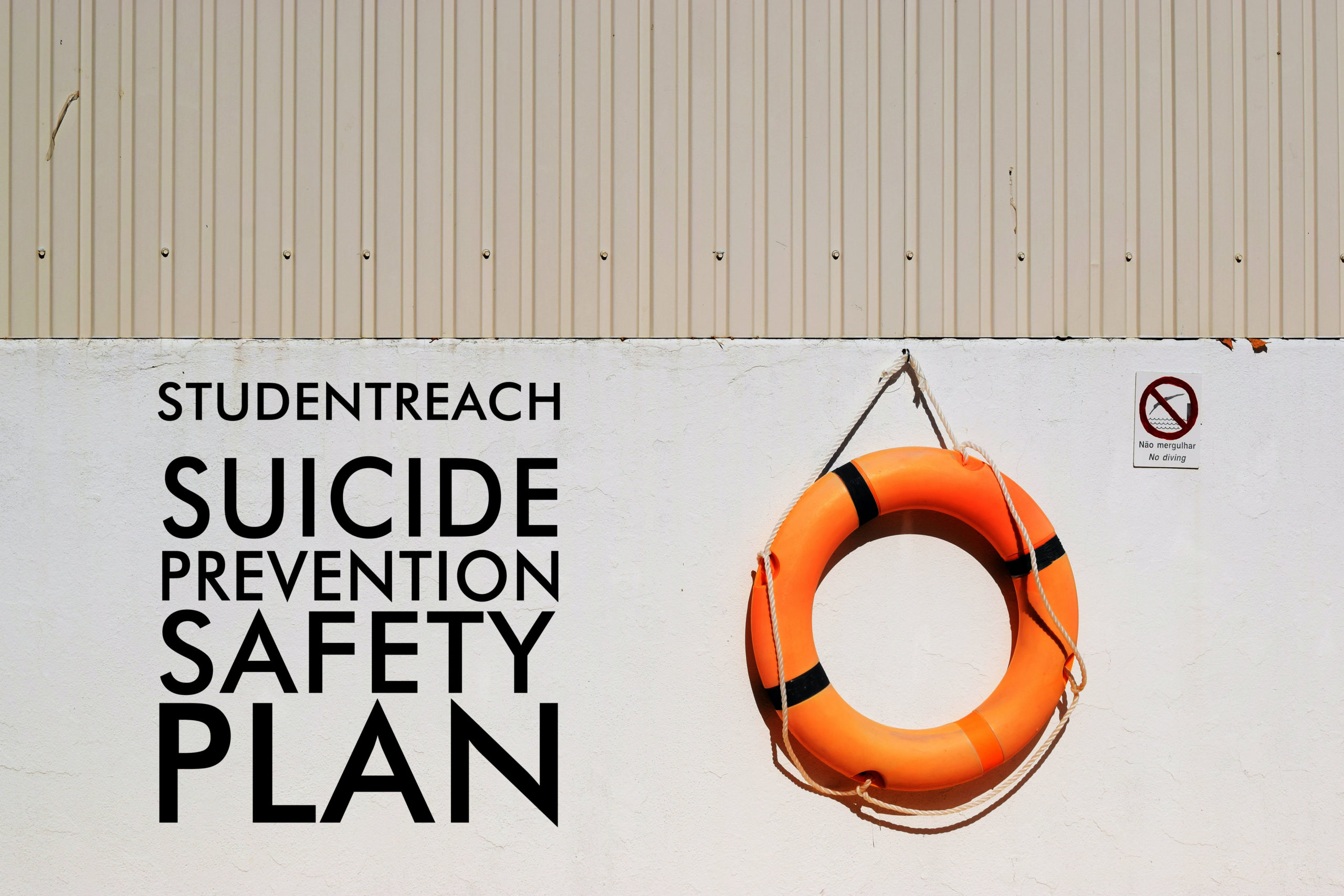6 Steps to Developing a Suicide Safety Plan (With your Teen) [2021]
You’re probably here because you or someone close to you is currently at a time of crisis or has been in the past.
A suicide safety plan is a list of resources and instructions created as a contingency plan for when are experiencing a mental health crisis and thoughts of self-harm are present.
This tool is intended to help you form a safety plan for suicide.
Using this plan sooner rather than later makes it more effective.
Even if you do not have suicidal thoughts, or do not think you ever will, this is still a great resource to have in place should that day come.
It’s better to have a plan in place should a crisis arise, rather than wait until it happens.
- What this tool can do
- Helping teens with depression
- What is uCoach
- Step 1 – List Warning Signs
- Causes of concern
- Step 2 – List De-escalation and Diversion Techniques
- Step 3 – List People That Can be Contacted in a Time of Crisis
- Step 4 – Steps for Removing Access to Means of Suicide
- Step 5 – List Mental Health Professionals to Be Contacted in a Time of Crisis.
- Step 6 – List Reasons to Stay Alive
- Safety Plan Template
What this tool can do:
- Provide a list of alternatives to self-harm
- Identify vulnerabilities that can be targeted for self-treatment and professional treatment
- Make you aware of when an individual is in crisis and how you can be a part of a team of supporters
What this tool cannot do:
- Serve as a replacement for professional help
- Prevent self-harm
- Serve as professional medical or mental health advice
The video and this accompanying guide are only a short primer, but we hope it helps.
For other StudentReach Suicide prevention resources, go to studentreach.org/prevention.
At a time of online learning, teen anxiety and depression are on the rise.
Your teenagers are feeling isolated and grief over everything they have had canceled.
Note: The content is not intended to be a substitute for professional medical advice, diagnosis, or treatment. Always seek the advice of your physician or other qualified health provider with any questions you may have regarding a medical condition.

WARNING: The information in this packet could be triggering to individuals experiencing a mental health crisis. If you are having suicidal thoughts, contact the National Suicide Prevention Lifeline for support and assistance from a trained counselor. If you or a loved one are in immediate danger, call 911.
Crisis Text Line: Text HOME to 741741
Suicide Prevention Hotline (1-800-273-8255)
HELPING TEENS WITH DEPRESSION

Everyone experiences depression.
However, due to hormonal and developmental factors that are intrinsic to their stage of transition from childhood to adulthood, teenagers experience depression more than most people.
This is experienced emotionally and physiologically, which compounds the difficulty. The video and this accompanying guide are only a short primer, but we hope it helps.
What is uCoach

This article is part of a series of resources called uCoach which is a resource for parents, educators, mentors, faith-based youth workers, relatives, coaches, or anyone working with teenagers.
We have an ongoing YouTube series with videos and handouts to help the teenager in your care. These are our best teenage parenting tips and teacher resources.
This series is your guide to helping your teens during this time of COVID, social distancing, and distance learning.
The videos can be found here.
These resources focus on life skills, social-emotional regulation, and other important concepts.
They are based in cognitive behavioral therapy, creative communication, and mentoring techniques, which are proven to be effective and simple to understand.
This video and guide on Suicide Safety Planning is our latest installment in the uCoach series.
Step 1 – List Warning Signs

These are the behaviors and emotions that when you are experiencing them all together, can lead to you having a mental health crisis. The behaviors and emotions will be specific to you. Not every behavior change, or emotion are cause for concern. Evaluate for yourself whether of not they will lead to a crisis.
Questions to assist you:
- Am I isolating myself? Is hanging out with my friends draining? Am I constantly tired? Do I lack energy to do simple things? Do I feel indifferent to things that happen to me?
- If you were to describe yourself as not doing well mentally, what does that look like for you? Think about your attitudes, feelings, and reactions.
- A few examples of thinking patterns are feeling hopeless, feeling as if you are a burden to others, thinking you have no reason to live etc.
- Causes for concern are listed below
When to use this tool: When you recognize that you are experiencing the warning signs you listed above.
How to use this tool: By recognizing that you are experiencing your warning signs you can move onto diversion and de-escalation techniques. Making others aware of your warning signs allows them to intervene before a situation escalates to a crisis.
CAUSES OF CONCERN

Your teen talks about…
| Killing themselves
| Feeling hopeless
| Having no reason to live
| Being a burden to others
| Feeling trapped
| Unbearable pain

Behavior changes…
| Increased use of alcohol or drugs
| Withdrawing from activities
| Isolating from family and friends
| Sleeping too much or too little
| Visiting or calling people to say goodbye
| Aggression or Fatigue

Emotional distress
| Anxiety
| Loss of interest
| Irritability
| Humiliation/Shame
| Agitation/Anger
| Relief/Sudden Improvement

Health…
| Bipolar disorder
| Schizophrenia
| Aggression, Mood changes
| Poor relationships
| Conduct disorder
| Chronic pain
| Traumatic brain injury

Environment
| Access to lethal means
| including firearms and drugs
| Prolonged stress, such as bullying,
| relationship problems, rejection, divorce,
| Other life transitions, loss
| Exposure to another person’s suicide or
| Sensationalized accounts of suicide

Family history
| Family history of suicide
| Childhood abuse, neglect, or trauma
| Family history of addiction
| Previous suicide attempt
*Download the Causes of Concern PDF here!
Step 2 – List De-escalation and Diversion Techniques

These techniques are meant to help divert your mind to a more positive environment, and to distract you from negative thinking patterns. These should be calming techniques, not something that will stress you out and keep you in a negative mindset.
Questions to assist you: What are activities I enjoy? What helps me calm down when I’m feeling overwhelmed? Does physical activity clear my mind? How have I successfully dealt with a mental health crisis in the past?
Example:
- Situation: You get into an argument with your parents and are feeling heated and overwhelmed.
- Body sensation: Feeling the need to hurt yourself.
- Diversion: Go for a run.
This allows your body to run off your emotions. The physical exertion releases endorphins in your brain, which will help combat the negative emotions.
When to use this tool: When you recognize that you are experiencing the warning signs you listed above.
How to use this tool: Use these techniques to bring yourself out of a crisis. If you are unable to de-escalate your mental state using the things listed above, that is when you implement step 3: calling the people on your list.
Step 3 – List People That Can be Contacted in a Time of Crisis

This list should include trusted adults, peer mentors, family members etc. If you list friends be sure they will be able to help you through a crisis. Remember you will be emotionally distraught if the need to use this list arises. You need someone who can help. List the hours each person can be reached alongside their phone numbers and their means of contact (call or text).
Questions to assist you: Who can I contact to walk me through this situation? Who will always answer their phone? Who can I trust?
Examples:
- Situation: You get into an argument with your parents and are feeling heated and overwhelmed.
- Body sensation: Feeling the need to hurt yourself.
- Contact: Call a mentor and express that you are thinking of hurting yourself and are unable to de-escalate your emotions on your own.
When to use this tool: When you recognize that you are experiencing the warning signs you listed above.
How to use this tool: By recognizing that you are experiencing your warning signs and allowing another person to intervene before a situation becomes critical.
Step 4 – Steps for Removing Access to Means of Suicide

When you remove potentially harmful substances or objects from your sight, the harder it becomes to use these to harm yourself. It does not matter how small the object is or what it is. If you could hurt yourself with it, get rid of it. This gives you more time to de-escalate your emotions and to think through the situation.
Questions to assist you: What would I use to harm myself? Do I need these things out of sight? Do I just need to remove certain objects or medications from my room? Are these things better outside the house completely?
Example:
- Situation: You get into an argument with your parents and are feeling heated and overwhelmed.
- Body sensation: Feeling the need to drink.
- Removal: Dump out the bottle of alcohol.
When to use this tool: When you recognize that you are experiencing the warning signs you listed above.
How to use this tool: Use these techniques to bring yourself out of a crisis. If you are unable to de-escalate your mental state by using a diversion, that is when you implement calling the people on your list.
Step 5 – List Mental Health Professionals to Be Contacted in a Time of Crisis

This should include 24/7 hotlines, mental health providers. The hours each person can be reached alongside their phone numbers and their means of contact (call or text).
Questions to assist you: Who can I contact to walk me through this situation? Am I in immediate danger? Is it after hours? Do I need to call a hotline?
Examples:
- Situation: You get into an argument with your parents and are feeling heated and overwhelmed.
- Body sensation: Feeling the need to hurt yourself.
- Contact: Call the suicide hotline and express that you are thinking of hurting yourself and are unable to de-escalate your emotions on your own.
When to use this tool: When you recognize that you are experiencing the warning signs you listed above.
How to use this tool: By recognizing that you are experiencing your warning signs and allowing another person to intervene before a situation becomes critical.
Step 6 – List Reasons to Stay Alive

Sometimes it’s the little things that really make us happy in life.
They can be as simple as things like watching your favorite show or being grateful for an opportunity you have.
It helps to think about other things rather than focus on the pain you are feeling.
Studies have shown that writing down the things you are grateful for helps to strengthen your mental health.
Questions to assist you: What make me happy? What do I enjoy doing? What is relaxing? What am I grateful for?
Examples:
- When the two characters you’re rooting for in a TV show finally get together.
- Finding something good to watch on Netflix.
- Warm hugs.
- A home-cooked meal.
- Being grateful for family and friends.
When to use this tool: When you recognize that you are experiencing the warning signs you listed above.
How to use this tool: Use these techniques to bring yourself out of a crisis. If you are unable to de-escalate your mental state using the techniques you listed, that is when you implement calling the people on your list.
StudentReach Suicide Prevention Safety Plan Template
Step 1 – Warning signs
These are the behaviors and emotions that when you are experiencing them all together, can lead to you having a mental health crisis. Remember: these are specific to you.
1.__________________________________________________________________________________
2.__________________________________________________________________________________
3.___________________________________________________________________________________
Step 2 – De-escalation and Diversion Techniques
These techniques are meant to help divert your mind to a more positive environment, and to distract you from negative thinking patterns.
1.__________________________________________________________________________________
2.__________________________________________________________________________________
3.___________________________________________________________________________________
Step 3 – People That Can be Contacted in a Time of Crisis.
List the hours each person can be reached alongside their phone numbers and their means of contact (call or text).
Name____________________________________________________
Phone______________________________
Hours______________________________
Name____________________________________________________
Phone______________________________
Hours______________________________
Name____________________________________________________
Phone______________________________
Hours______________________________
Name____________________________________________________
Phone______________________________
Hours______________________________
Step 4 – Steps for Removing Access to Means of Suicide
It does not matter how small the object is or what it is. If you could hurt yourself with it, get rid of it.
- ____________________________________________________
- ____________________________________________________
- ____________________________________________________
Step 5 – Mental Health Professionals to Be Contacted in a Time of Crisis.
National Suicide Prevention Lifeline:1-800-273-8255
Name____________________________________________________
Phone______________________________
Hours______________________________
Name____________________________________________________
Phone______________________________
Hours______________________________
Name____________________________________________________
Phone______________________________
Hours______________________________
Step 6 – Reasons to Stay Alive
Studies have shown that writing down the things you are grateful for helps to strengthen your mental health.
1._____________________________________________________________________________
2._____________________________________________________________________________
3._____________________________________________________________________________
4._____________________________________________________________________________
5._____________________________________________________________________________
6._____________________________________________________________________________
If you found this post helpful drop a note below to let us know your thoughts!
About the Authors:
Jeff Devoll, executive director of StudentReach, is an international speaker, trainer, facilitator and mentor to students and leaders.
Jeff has spoken to over 1,000,000 people from 40 states and 40 countries.
But Jeff is more than a speaker, he and his team have taken more than 8,000 volunteers on domestic and international “expeditions” to help schools andimpoverished people around the world.
More than 3000 students have been mentored through StudentReach’s mentoring and coaching programs, most of them highly at-risk students.
Robyn Cook is from Flint, Michigan, and is a graduate of Michigan State University.
She holds a bachelors degree in Religious Studies.
She is writer and editor extraordinaire.
Robyn is a lover of all things art and pasta.
Request More Info!
Subscribe to our uCoach series!
StudentReach
School Presentation | Life Coaching | Volunteering Abroad
Why you should donate to StudentReach:
We are not a for-profit middleman or third-party donation site – we are the actual non-profit.
We will use the proceeds to change peoples lives!
We work in:
- United States
- Baja, Mexico
- Zambia, Africa
- Nicaragua, Central America
What we do:
- Housing
- Water Projects
- Education
- We mentor at-risk youth
- We work with schools to prevent exploitation, human trafficking and suicide
Taking a trip with StudentReach is way more than just traveling – it’s you being a hero to someone who desperately needs help.
We work with people living in absolute poverty.
What can you do to help? More than you think. You can be a hero.
Come on a trip with us today!
DONATIONS IN THE PAST HAVE HELPED:




Leave a Reply
Want to join the discussion?Feel free to contribute!